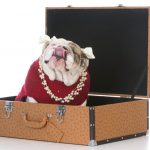How To Fly with a Bulldog: 9 Tips for Safe Travels

Your planning a big family vacation and want to include your fur child on the fun. Or maybe you want to take your bully to their first big show competition. Either way, you want to fly with a bulldog and you’re worried. After all, bulldogs don’t have a great history of flying.
How to fly with a bulldog? Check the airlines pet policy. Some airlines don’t allow brachycephalic breeds to fly in the cargo area of the airplane because there have been too many deaths. Federal law also requires a health certification from a veterinarian no longer than 10 days before interstate travels. For airlines that accept bulldogs, here are safe travel guidelines.
- Travel in mild weather conditions if possible
- Maintain health to minimize travel risk
- Crate train your bulldog
- Provide a large dog water bottle
- Pack a favorite toy or blanket
- Label your crate with contact information
The U.S. Department of Transportation said that brachycephalic dogs (short nosed dogs) including bulldogs are more likely to die on an airplane than dogs with normal snouts. From 2005 to 2010, 122 dogs died while because of flying, and one half of those dogs were brachycephalic breed dogs. Twenty percent of the 122 dog deaths related to flying were English Bulldogs (source). That’s a huge number and that is a risk that isn’t worth it.
Most dogs fly in the cargo hold with the luggage underneath the main cabin of the airplane. We all know it can get a little frigid down there and it is unsafe for brachycephalic breeds like the bulldog to fly in those harsh conditions. We’ll give you tips on how to fly with your bulldog safely.
Are Bulldogs Safe to Fly in the Cargo Hold?
It’s a well-known fact that Bulldogs have a hard time breathing. They are a brachycephalic breed, which refers to their short snout. The short nostrils, along with their elongated soft palate, blocks the airflow and causes breathing problems. This really becomes a problem when dogs are exposed to extreme temperatures as dogs control their eternal temperature with breathing.
Not only is your dog going to be exposed to the temperature under the airplane, but they will be exposed to the temperature on the tarmac, both temperatures can be extreme for bulldogs. Whether its hot or cold, the situation can be dangerous for a bulldog. A dog cools down its body through panting and bulldogs have a hard time breathing, let alone panting. Bulldogs have to work much harder than normal snout dogs to pant and cool their bodies. Tarmacs can be hot during the summer months, taking off in an airplane, turbulence, cold air underneath the airplane, it’s all stressful to the bulldog. The stress can cause them to pant and over exert themselves, and even pass out, or even die.
Is the Cargo Hold Air Conditioned
The bulk area of the cargo hold where the dogs are kept is actually air conditioned. The air is directed from the main cabin, but by the time it reaches the cargo hold area, it is a little cooler. This area doesn’t have as much insulation as the main cabin either. The temperature of the cargo hold can vary but the air is often about 60 degrees Fahrenheit. The normal baggage hold is about 40 degrees, but often less.
The low temperature along with the stress of flying for a dog, puts too much pressure on the brachycephic dogs. Knowing that dogs regulate body temperature through their noses and pant when they are stressed are the main reasons why bulldogs should not fly in the baggage hold of an airplane.
Tips To Minimize Risk and Stress of Travelling For your Bulldog
- First and foremost, check the pet policy of the airline you plan to use before you purchase tickets. Some airlines claim to be pet friendly, but they are actually not very pet friendly at all. For example, frontier allows pets to travel in cabin, so long as they can stay in a carrier underneath the seat in front of you. You may not remove them from their crate during flight for any reason. The fee to travel with a pet is also $75.00 one way and they don’t allow any animals in the cargo hold. To fly with bulldogs on this airline and airlines with similar pet policies would be impossible.
- Always try to keep your bulldog at a normal weight and keep them active. Bulldogs with an unhealthy weight, other medical conditions, or older pets are at a higher risk and may not be cleared to fly from your veterinarian.
- Crate train your bulldog before you travel. If your bulldog is used to being in their crate for long periods, this will keep the stress levels lower. Travelling in general is going to be stressful for them. Its loud and bumpy, especially in the cargo area. They are most likely going to be scared. The crate may be a comfort to them if they have been crated trained. If you are planning on crate training your puppy here are a few of my secrets to help your bulldog adjust and how to deal with separation anxiety. Find a crate with a lot of ventilation and at least 6 inches of space on all sides. This will give them plenty of room to breath in the crowded cargo hold.
- Be sure to provide water to your bulldog while flying as this will help them regulate their temperatures and stay calm as well.
- Give your bulldog a familiar toy or small thin blanket to line the crate. A toy with a scent from home will be comforting. A thick blanket might get too wrapped up and tangled in the crate. If you are worried that the crate will be hard and uncomfortable, you can purchase a crate with padded sides.
- If you have a French Bulldog or a small bulldog in general, they may be allowed to travel underneath the seat. Check with the airline’s pet policy when you make your reservation. Some airlines may charge a fee for a pet in the cabin. Airlines may have size restrictions for carriers in the cabin.
- Consider your flight times. As we talked about before, the temperature is not controlled when you are on the tarmac. The temperature controls are usually off until the airplane is in flight. If you get stuck on the tarmac in adverse hot or cold weather, your pet is exposed to that temperature. So, plan to take your bulldog on an airplane in the spring and the fall when temperatures are mild. If you have a layover, consider the temperature where your layover is and how long your bulldog will be exposed to that temperature, for the safety of your bulldog.
- You must get a health certificate from a veterinarian no longer than 10 days before interstate travel. This is required by law. If your bulldog is travelling to Hawaii with you, the dog must be quarantined for 120 days before travel. Check for regulations about dogs traveling internationally.
- Be sure to mark your crate with all your personal information. Check with the gate agent that all this has been done correctly. Be sure your dog has their tags and has been microchipped. Its one thing to lose your luggage, but to lose your dog is a whole-nother story.
Can Bulldogs Fly in the Cabin of the Airplane?
French Bulldogs are usually small enough to fit in the luggage area in a crate on board the airplane. Many airlines charge an additional, steep fee to carry an animal on board. There are also size restrictions to the crate you can bring on board so check the airlines pet policy before you purchase a ticket. But then there is the English Bulldog, and all the other bulldog breeds that are far too large to fit underneath the seat in front of you. You may have to jump through some hoops to get your bulldog on board, but it’s not impossible.
- Specially train and certify your dog as a service animal. Training can be expensive and honestly grooling. The International Association of Assistance Dog Partners require at least 120 training hours. If you are a frequent traveler and want to take your bulldog along without the worry of checking your dog into the cargo area, this might be worth your time. You must find a reputable trainer so you can have official and proper paperwork. Airlines are sticklers about this. But if you do it right, you can fly with your bulldog in the cabin, which is the most ideal situation.
- You can also charter a plane, but that will really cost you. There are services to help you find and connect with other pet parents travelling to and from the same destination so you can travel together and split the cost of the chartered plane. Check out Pet Jets if this option is appealing to you. If you are permanently moving across the country or internationally there are pet relocation companies who will walk you through the process of moving your pet and even have airplanes just for pets.
Other Options
Maybe you don’t want to fly with a bulldog anymore. You can always drive instead with your bulldog, so long as you are staying stateside. Here six handy tips for road tripping with your bully friends. This may not be the most ideal option, but you wouldn’t have to worry about your bully for one second. They’d be right there with you the whole time. In fact, the Bulldog Club of America recommends driving to competitions to save you the worry and hassle of flying with a bulldog.
Leave your Bully buddy with a trusted friend or family member. Yes, you will miss them and they will miss you, but it could be a better option than putting them underneath an airplane. You can even leave them with a trusted kennel. These people are trained to take care of all pets and their special needs. You can even leave them with a dogie bed from home and food and medicine for their special needs. Some kennels will even send you a picture of your dog every day to your phone or you can check them out on their live cameras. Its amazing what kennels will do for your dog!
My last recommendation, if you ABSOLUTELY must fly with your dog and have no other options, is to have the corrective surgery on their nasal passage done. The surgery will correct their elongated soft palate and stenotic nares and greatly improve airflow, thus creating easier breathing for your bulldog and they will be able to control their body temperature more efficiently, hopefully making it safer for them to fly.
Conclusion
To fly with a bulldog will most likely be a nerve-wracking experience (for both of you) until you reach your destination and are reunited with your bully. There are tips to help the big travel day go as smoothly as possible. Travel when the weather is mild, and train your bully to sit in a crate, keep your dog active so they are healthy for travelling. You will eliminate the stress of travelling for you and your bulldog, if you are prepared.

































